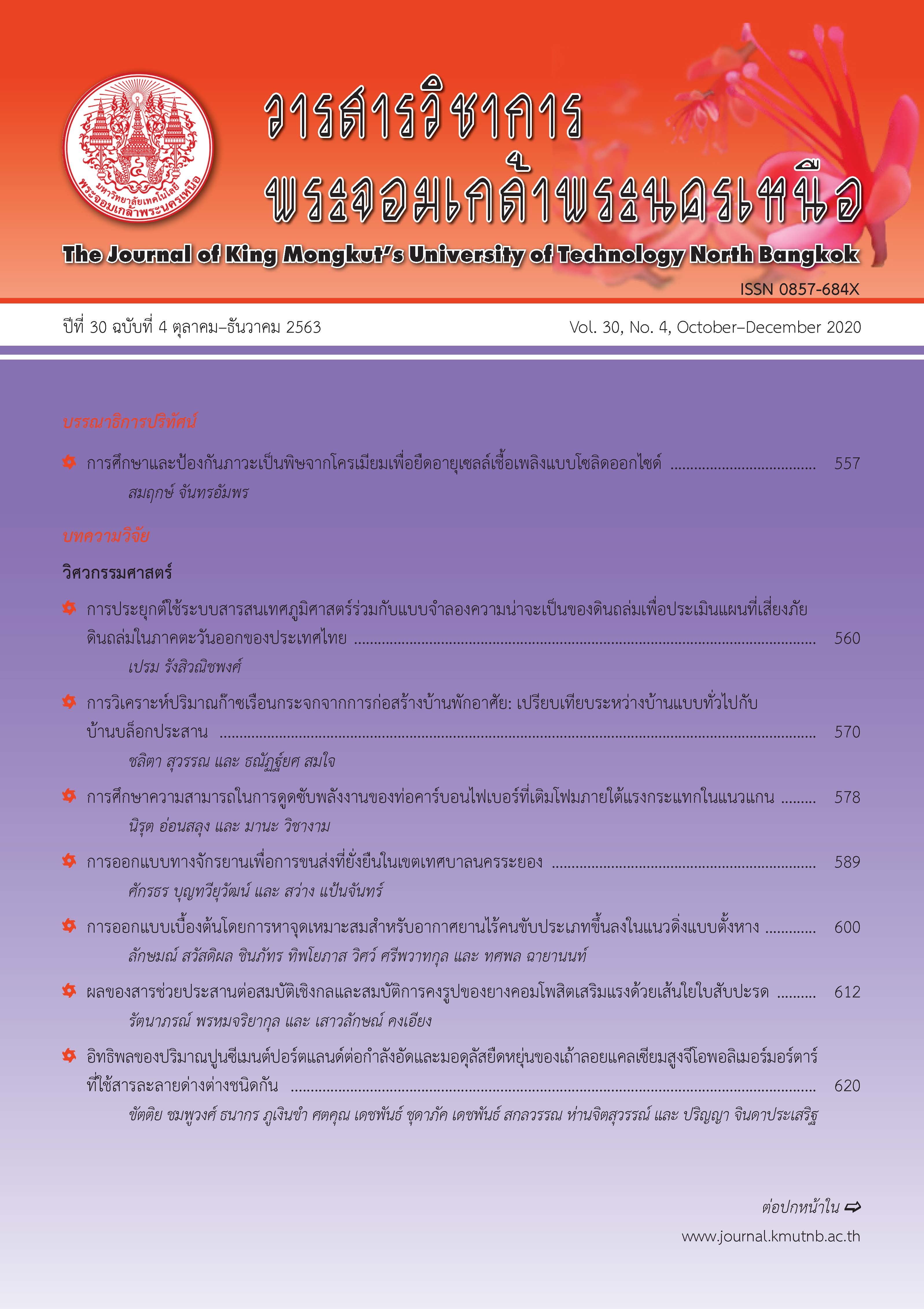Comparative Greenhouse Gas Evaluation of House Construction: A Conventional House versus an Interlocking Block House
Main Article Content
Abstract
This research aimed to evaluate the greenhouse gas emissions of 2 types of single-family pilot houses with different materials of opaque wall, a conventional concrete block house and an interlocking block house, following the principles of life cycle assessment. The scope of the study covered the analysis of the amounts of greenhouse gas emission from the acquisition of global resources and the production of construction materials. The results of the study showed that the total amount of greenhouse gases released from the conventional house construction and the interlocking block house construction were 13,152.02 and 8,322.62 kg CO2e, respectively. It was 257.88 and 155.28 kg CO2e per 1 sq.m. of the utility space of the house, respectively. Since the interlocking block house is a load-bearing wall system, without columns and beams, and without interior and exterior wall plastering, the amount of greenhouse gas contributed by cement and reinforced steel, which were dominantly greenhouse gas contributors, was avoided. The researchers suggested further study to extend the scope to cover the whole life cycle of the house including the use stage and the end of life stage. Eco-efficiency analysis should be considered for more definitive conclusions.
Article Details
The articles published are the opinion of the author only. The author is responsible for any legal consequences. That may arise from that article.
References
[2] United Nations Environment Programme, “Towards a green economy: Pathways to sustainable development and poverty Eradication-A synthesis for policy makers,” St-Martin-Bellevue, France, 2011.
[3] H. Birgisdóttir and F. Nygaard Rasmussen, “Introduction to LCA of buildings,” Danish Transport and Construction Agency, 2016.
[4] J. T. Houghton, L. G. Meira Filho, B. Lim, K. Treanton, I. Mamaty, Y. Bonduki, D. J. Griggs, and B. A. Callander (Eds), “IPCC guidelines for national greenhouse inventories; Volume 2 Workbook,” Intergovernmental Panel on Climate Change, Paris, France, 1997.
[5] Thailand Concrete Association, “Guidelines for greenhouse gas evaluation from concrete production,” Thailand Concrete Association, Bangkok, Thailand, 2011.
[6] Thailand greenhouse gas management organization. Carbon footprint of product. Carbon Label & Carbon Footprint For Organization. Bangkok, Thailand [Online]. Available: http://thaicarbonlabel.tgo.or.th/products_approval/products_approval.pnc.
[7] K. Tachantuek, “Greenhouse gas emission assessment and economic analysis of electricity generation from Pennisetum Purpureum cv. Pakchong 1 using completely stirred tank reactor anaerobic digester,” M.S. thesis, Department of Energy Engineering, Faculty of Engineering, Chiengmai University, 2013 (in Thai).
[8] N. S. A. Asman, N. Bolong, A. K. Mirasa, I. Saad, H. Asrah, and L. C. Han, “Life cycle assessment of interlocking bricks system construction-A review,” presented at the Joint Seminar on Science, Engineering and Technology, South Korea, Apr. 2–6, 2018.
[9] N. Rungreagthanaphol, “Greenhouse gas emission from construction and operation of Bann Pracharat Project of national housing authority,” M.S. thesis, Department of Architecture, Faculty of Architecture, Chulalongkorn University, 2016 (in Thai).
[10] Thailand greenhouse gas management organization. (2019, Oct.). Greenhouse gas emission factors. Carbon Label & Carbon Footprint For Organization. Bangkok, Thailand [Online] Available: http://thaicarbonlabel.tgo.or.th/admin/uploadfiles/emission/ts_f2e7bb377d.pdf
[11] A. Korre and S. Durucan. “EVA025-Final report: Aggregates industry life cycle assessment model: Modeling tools and case studies,” The Old Academy, UK, 2007.
[12] Thai greenhouse gas management organization, “The guidelines for product carbon footprint assessment,” National Science and Technology Development Agency, Pathum Thani, Thailand, 2010.
[13] Thai greenhouse gas management organization, “The guidelines for product carbon footprint assessment,” Carbon Label & Carbon Footprint For Organization, Bangkok, Thailand, 2015.
[14] G. P. Hammond and C. I. Jones, “Embodied energy and carbon in construction materials; Inventory of carbon and energy (ICE) V.2.,” in Proceedings of the Institution of Civil Engineers - Energy, vol. 161, no. 2, 2008, pp. 87–98.
[15] M. Puettmann, E. Oneil, J. Wilson, and L. Johnson, “Cradle to gate life cycle assessment of softwood plywood production from the southeast,” The consortium for research on renewable industrial materials (CORRIM), 2013.
[16] Ng. Ruisheng, C. W. P. Shi, J. S. C. Low, H. M. Lee, and B. Song, “Comparative carbon footprint assessment of door made from recycled wood waste versus virgin hardwood: case study of a Singapore wood waste recycling plant,” Glocalized Solutions for Sustainability in Manufacturing, in Proceedings. the 18th CIRP International Conference on Life Cycle Engineering, 2011, pp. 629–634.
[17] M. Asif, T. Muneer, and R. Kelley, “Life cycle assessment: A case study of a dwelling home in Scotland,” Journal of Science Direct Building and Environment, vol. 42, pp. 1391–1394, 2007.
[18] S. Gheewala and O. Kofoworola, “Environmental life cycle assessment of a commercial office building in Thailand,” International Journal of Life Cycle Assessment, vol. 13, pp. 498–511, 2008.
[19] C. J. Koroneos, A. Th Dompros, and M. Loizidou, “Life cycle assessment of an office building in Greece,” Journal of School of Chemical Engineering, 2007.
[20] M. Boonnak, “Eco-design of dwelling home in Thailand,” M.S. thesis, Department of Energy and Environmental Technology, Faculty of Engineer, Thammasat University, 2011 (in Thai).

